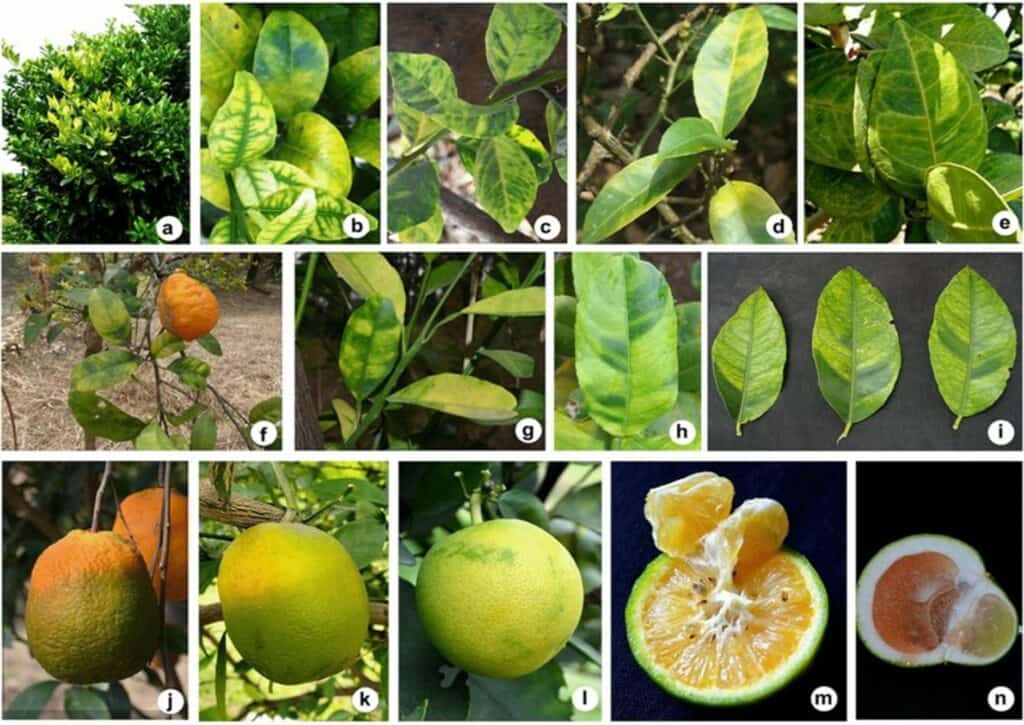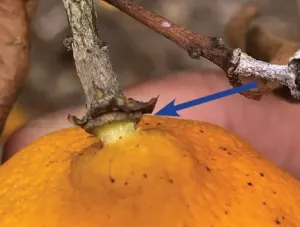The citrus greening disease is the most severe concern for the citrus plant. It is also known as Huanglongbing (HLB) or yellow dragon disease caused by a vector-transmitted pathogen. There is no cure for this disease. The disease is currently found in California, Florida, Georgia, Louisiana, Puerto Rico, South Carolina, Texas, and the U.S. Virgin Islands. It is a severe threat to all types of citrus trees such as lemon, orange, grapefruit, tangerine, curry leaf, etc. If left unchecked, it can also destroy the trees. Once the infection spreads, a citrus fruit turns bitter and destroys its quality and quantity entirely. The trees then become useless.
The citrus greening disease has different symptoms that vary in each plant. However, the symptoms include the following:
- New leaves emerge small and yellow.
- Mottling or blotching of the leaves.
- Yellow shoots.
- Enlarged and corky veins of leaves.
- Fruits grow small and have green ends.
- Fruits are filled with small, dark, and aborted seeds.
- The juice is bitter.

Huanglongbing (HLB) was first detected in the USA in 2005. The first reports of the disease spreading in the citrus trees occurred in Florida (2005). It spread through the citrus-producing areas in Florida and reduced the production of citrus by 75%. In 2008, HLB was detected in Louisiana, and in 2009, the disease was detected in Georgia and South Carolina. In 2012, HLB was detected in Texas and the residential areas of California. It is spread by a tiny insect called the Asian citrus psyllid (ACP, Diaphorina citri) which feeds on citrus. The Asian citrus psyllid was first discovered in Florida in 1998. Now, it is present in all citrus-producing regions of the USA. This disease is not harmful to animals or humans but negatively affects agricultural production due to the destruction of the crop and even citrus trees. Farmers must rip the trees out of the ground and start growing the orchard all over again. This not only requires a large investment but also takes several years to complete.

Oranges play an important role in the American food industry. It has consistently ranked as the third most consumed fresh fruit behind bananas and apples. Oranges are a great source of vitamin C; despite their continued popularity, fresh oranges have declined over the past several decades. There are various reasons for this including the damage by Hurricane Irma in September 2017, the presence of HLB in Florida, and unfavorably hot weather conditions in California. HLB’s effect on the quality of fruits is described below:
- Highly symptomatic: The fruit is not acceptable, a worst-case outcome
- Non-symptomatic: The fruit is acceptable, but they are slightly different from the healthy ones
Preharvest fruit drop is much greater in HLB-infected trees, even with nutrient enhancement.

Citrus utilized production for the 2021-22 season totaled 5.61 million tons, which is a drop of 19 percent from the 2020-21 season. California accounted for 62 percent of the total United States citrus production; Florida totaled 36 percent, and Texas and Arizona produced the remaining 2 percent.
As there is no cure for this disease, current strategies focus on vector control (i.e., controlling the spread of infection) and management of infected trees. The practices involve using pesticides and removing infected or symptomatic trees from regions where disease incidence is low. Citrus fruit growers in Florida are using foliar nutritional spray products that contain macro and micro-nutrients. to compensate for the lack of nutrients due to the disease.
The compounds are believed to activate “systemic acquired resistance” pathways in plants (such as salicylic acid) to increase tree defense response and increase the production of citrus fruits in the regions where the infection is low to compensate for the high demand for citrus fruits.
